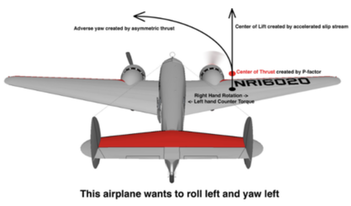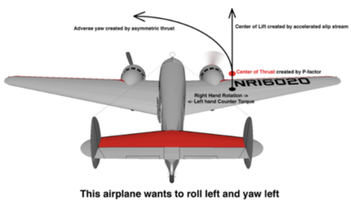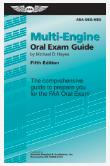Multi Engine Flight Training in Alaska

A Multi Engine Rating is required anytime a pilot is going to log flight time in an airplane that has more than one engine. The rating is applied to either the Private Pilot or Commercial Pilot license - whichever certificate the applicant possesses.
Multi Engine Flight Training in Alaska is, for the most part, all about learning how to fly the airplane if one of the two engines quits. Due to the placement of an engine on each side of the airplane, if one engine were to quit, there would be asymmetric thrust, creating a yawing moment, which would rotate the airplane about its vertical axis. At low airspeeds, the prop-wash created by the functioning engine over the wing, as well as the increase in airspeed of the forward yawing wing may create such an excess of lift on that one wing that the airplane flips itself over.
During Multi Engine flight training In Alaska, you will actually turn one of the engines off in flight and then reactivate it! It is a challenging but very satisfying and exciting rating to attain.
Multi Engine Flight Training in Alaska is, for the most part, all about learning how to fly the airplane if one of the two engines quits. Due to the placement of an engine on each side of the airplane, if one engine were to quit, there would be asymmetric thrust, creating a yawing moment, which would rotate the airplane about its vertical axis. At low airspeeds, the prop-wash created by the functioning engine over the wing, as well as the increase in airspeed of the forward yawing wing may create such an excess of lift on that one wing that the airplane flips itself over.
During Multi Engine flight training In Alaska, you will actually turn one of the engines off in flight and then reactivate it! It is a challenging but very satisfying and exciting rating to attain.
Multi Engine Flight Training in Alaska does not require the applicant to pass an additional written aeronautical knowledge test. There is also not a minimum number of aeronautical experience flight hours required to take the checkride.
The required knowledge areas and flight training for a Multi Engine Rating can be found under the type of certificate for which the rating is being sought. For example, a Private Pilot who is seeking to add a Multi Engine rating to her or his certificate will look under Part 61 Subpart E, and a Commercial Pilot will need to look under Part 61 Subpart F.
It should be noted that Single Engine and Multi Engine ratings each require their own checkride for each type of certificate. For example, it is possible for a student pilot to learn how to fly a Multi Engine airplane initially and take his or her checkride for a Private Pilot License in a Multi Engine airplane in Alaska. Upon passing, that pilot would be a Private Pilot with a Multi Engine rating. That pilot would then need to acquire additional training in a Single Engine airplane and take an additional Private Pilot checkride in a Single Engine airplane in order to fly a Single Engine airplane.
Ready to begin your Multi Engine Flight Training in Alaska? Contact Us today and let us help you find an Alaska Flight School and Flight Instructor that suits your needs.
Below are the checkride tasks for Multi Engine add-on ratings for the Private and Commercial Pilot certificates.
The required knowledge areas and flight training for a Multi Engine Rating can be found under the type of certificate for which the rating is being sought. For example, a Private Pilot who is seeking to add a Multi Engine rating to her or his certificate will look under Part 61 Subpart E, and a Commercial Pilot will need to look under Part 61 Subpart F.
It should be noted that Single Engine and Multi Engine ratings each require their own checkride for each type of certificate. For example, it is possible for a student pilot to learn how to fly a Multi Engine airplane initially and take his or her checkride for a Private Pilot License in a Multi Engine airplane in Alaska. Upon passing, that pilot would be a Private Pilot with a Multi Engine rating. That pilot would then need to acquire additional training in a Single Engine airplane and take an additional Private Pilot checkride in a Single Engine airplane in order to fly a Single Engine airplane.
Ready to begin your Multi Engine Flight Training in Alaska? Contact Us today and let us help you find an Alaska Flight School and Flight Instructor that suits your needs.
Below are the checkride tasks for Multi Engine add-on ratings for the Private and Commercial Pilot certificates.
|
The Private Pilot Multi Engine checkride is similar to the Single Engine checkride, but the following tasks will not be learned or tested in a Multi Engine airplane:
An asterisk (*) following a task means that this task is not required if the applicant does not hold an instrument rating. It should be noted that if one completes a Multi Engine add-on checkride without an instrument rating, and later on they pass the Instrument Rating checkride in a Single Engine airplane, they will need to take an additional checkride in a Multi Engine airplane that covers these tasks. Until then, they will have a "VFR Only" limitation on their Multi Engine rating. The Private Pilot ACS can be found here |
The Commercial Pilot Multi Engine checkride is similar to the Single Engine checkride, but the following tasks will not be learned or tested in a Multi Engine airplane:
An asterisk (*) following a task means that this task is not required if the applicant does not hold an instrument rating. It should be noted that if one completes a Multi Engine add-on checkride without an instrument rating, and later on they pass the Instrument Rating checkride in a Single Engine airplane, they will need to take an additional checkride in a Multi Engine airplane that covers these tasks. Until then, they will have a "VFR Only" limitation on their Multi Engine rating. The Commercial Pilot ACS can be found here |


